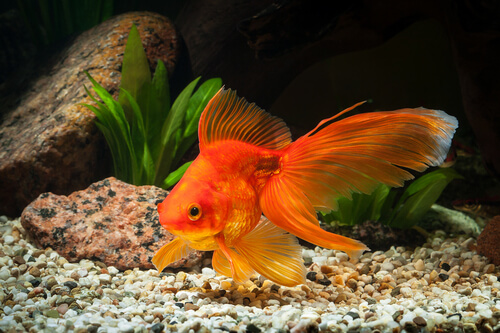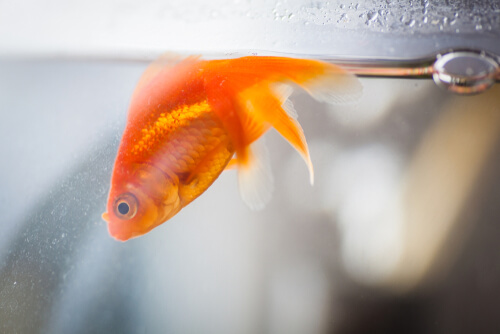The Goldfish: Characteristics, Feeding and Care

Fish, in general, are one of the best options for children to have as their first pets. They’ll learn to care for and enjoy the company of another living being, as well as learning about the responsibility of pet ownership seriously. The goldfish is one such example.
The goldfish (Carassius auratus) is one of the most popular fish to have at home. However, it isn’t always one of the easiest species to keep. Because of that, it’s important to know what their characteristics and care needs are.
Origin of the goldfish
The goldfish, belonging to the Cyprinidae family, is one of the most popular fish in aquariums around the world. Not in vain is one of the most captured species to spend the rest of his life in captivity.
The origin of this fish goes back to China, where they weren’t only bred for human consumption, but also to be domesticated. Currently, they’re part of many aquariums around the world.
In ancient China, it was very common to capture these fish for captive breeding. Since then, the creation of tanks gained momentum and, at the time of reproduction, different species were crossed. In this case, the most frequent mutation that was achieved was the golden coloration that stands out among the algae.

Goldfish characteristics
Size and color
The size of goldfish can vary considerably from one specimen to another. In this aspect, some can measure 10, 60, or even 90 centimeters in length (4, 24, and 35 inches).
On the other hand, with respect to color, the most common ones have very bright yellow and orange colorations, hence the name of the fish. In some cases, they may have small white spots.
Thanks to the process of selective breeding, different beautiful varieties have been created, but they’re still part of the goldfish. Among the most popular are the following:
- Comet: Similar to the normal goldfish but with larger and whiter fins.
- Celestial: Its eyes are seen as protrusions on the side of its face. Their coloration also varies between yellow-orange, red, and white.
- Ryukin: Its fins are elongated almost like a “veil” and its body has a kind of “hump” that gives it a peculiar appearance.
- Bubble: It has two large sacs under its eyes that look like bubbles.
- Oranda: It has a rather strange ornamentation on its head that resembles “curly hair”.
- Fantail: Characterized by a very large fan-shaped caudal fin.
Life expectancy
The life expectancy of the goldfish is quite high; they can live between 15 and 40 years approximately. It should be noted that this life expectancy is the same both in the wild and in captivity, as long as the person provides all the necessary care.
Weight
Weight is another aspect that varies considerably according to the species. In these cases, the smallest goldfish weighs about 0.3 kilos and the largest 30. Captivity has a great influence on the weight, since the fish won’t have as much space to grow and develop as in freedom.
Behavior
The behavior of the goldfish is one of the aspects that has made it one of the favorite pets of millions of people around the world. It’s calm and coexists very well with other species. Another interesting feature is that this fish creates colonies of up to seven fish of the same species, so it’s recommended to acquire several goldfish.
Although they don’t cause many conflicts in the aquarium, it’s important to avoid living with other small fish. This is because, as goldfish grow, they’re capable of devouring almost anything that enters their mouths. The best option is to keep them only with other specimens of the same species to avoid this problem.
Reproduction
Goldfish reproduction takes place in waters with plenty of vegetation, as it uses plants to anchor its eggs in them. It usually has an annual reproductive cycle that begins just after the winter period. In the southern hemisphere, this occurs during the months of May to June.
These fish reproduce by external fertilization, so their eggs and sperm have to be released at the same time. To do this, the male chases the female around the habitat. As soon as he catches up with her, both release their gametes (eggs and sperm) onto the surrounding vegetation.
The young hatch from the egg about 3 days later, although it may take longer if the water temperature is too cold. They’re independent at hatching and feed on small arthropods such as artemia. As time passes, they’ll begin to grow and reach sexual maturity in 1 to 3 years.
Goldfish feeding
In the wild, goldfish feed on seaweed, larvae, plankton, worms, and even small eggs of other species. However, in captivity, especially in large aquariums, they’re usually fed with larvae and dried vegetables.

If the fish is at home, it can also be fed with what we’ve described above, or another supplement indicated by the pet shop. The combination of plant and animal nutrients is essential for the optimal development of this species.
An important aspect to take into consideration is that the fish should be fed three times a day with very small amounts. The reason for this is that they only eat the food during the first two or three minutes and the rest is discarded.
Care
For the goldfish to have a long life it’s necessary to provide all its care needs. In this sense, you must take into account aspects such as the size of the tank, accessories, cleaning, and others.
Goldfish need enough space to swim constantly. Therefore, it’s advisable to buy a fish tank of no less than 100 liters (22 gallons). This should be decorated with small stones and coarse sand.
As far as aquarium plants are concerned, they shouldn’t interfere with the free circulation of the fish. The water temperature is also another important aspect to prevent the fish from getting sick, so it should be between 15 and 22 degrees Centigrade (60 to 71 Fahrenheit)
The goldfish is a pet that doesn’t require large investments of money and is very easy to maintain. With the necessary care in terms of habitat and food, it’s possible for them to develop and live for many years with an excellent level of health.
All cited sources were thoroughly reviewed by our team to ensure their quality, reliability, currency, and validity. The bibliography of this article was considered reliable and of academic or scientific accuracy.
- Castillo-Rivera, M., Ortiz-Burgos, S., & Zárate-Hernández, R. (2011). Estructura de la comunidad de peces estuarinos en un hábitat con vegetación sumergida: variación estacional y nictémera. Hidrobiológica, 21(3), 311-321.
- Lorenzoni, M., Ghetti, L., Pedicillo, G., & Carosi, A. (2010). Analysis of the biological features of the goldfish Carassius auratus auratus in Lake Trasimeno (Umbria, Italy) with a view to drawing up plans for population control. Folia Zoologica, 59(2), 142-156.
This text is provided for informational purposes only and does not replace consultation with a professional. If in doubt, consult your specialist.